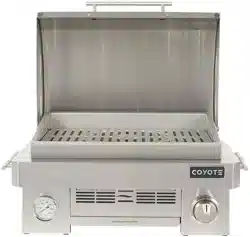Loading ...
Loading ...
Loading ...

8
Check your local building codes for the proper method of installation. In the absence of local codes, this unit
should be installed in accordance with the National Fuel Gas Code No. Z223.1-1998 USA or CAN/CGA-B149.1/.2
Natural Gas/Propane Code (Canada) latest edition or the National Electrical Code ANSI/NFPA No. 70 or the
Canadian Electrical Code CSA C22.1, 1990 or latest version.
IMPORTANT: Gas fittings, regulator, and installer supplied shut-off valves must be easily accessible.
LOCATION OF YOUR GRILL:
Locate the grill only OUTSIDE in a well-ventilated area. Never locate the grill in a building, garage, breezeway,
shed or other such enclosed areas without an approved ventilation system. When in use, the grill will
generate a lot of smoke. When installing your grill, select an outdoor location that will ensure there is adequate
area for the smoke to dissipate IN ORDER TO AVOID INHALATION OF POTENTIALLY TOXIC FUMES.
Ventilation Requirements for Proper Operation of your Coyote Grill
• Ventilation for a gas grill is absolutely mandatory to ensure that your grill performs as intended and to
ensure the safety of you, your family, and guests. Proper ventilation is necessary to allow heat inside
your grill to escape and also to allow any gas that has leaked from a tank or connection to escape
before a buildup of such gas can occur and possibly ignite. Failure to
provide proper ventilation will nullify Coyote’s warranty and will cause a risk of bodily injury or death.
• A simple way to think of what is occurring inside your grill is that when your burners are on, they are
emitting a flame that creates the heat to cook your food. This heat must exhaust or escape from the
grill, otherwise you would eventually have a unit that would not only build up intense heat but also
dangerous pressure. This could cause severe damage to not only the grill but any operators or people
or property near-by. The grill itself allows for ventilation mainly through the rear of the unit above the
rear panel but below the top of the hood. However, wind can act as a barrier to ventilation and
exhaust. This blockage of exhaust can cause problems and hazardous conditions. Therefore, great care
must be taken in selecting a location for your grill. This can cause the control panel and knobs to get
hot to the touch and possibly even burn your fingers, not to mention that it can melt all rubber gaskets
on the valves and damage the ignition system to where it will need full replacement.
• Ventilation and typical wind direction and conditions must always be considered when planning your
outdoor cooking island. Just the same as you would plan the layout and measure your indoor kitchen,
you must also do the same for the outdoors; but you cannot forget about Mother Nature and the
effects she can have on your outdoor cooking equipment.
Clearance:
• FROM NON-COMBUSTIBLE MATERIALS: Coyote grills can be placed directly on, or adjacent to,
non-combustible materials, subject to ventilation requirements. The hood on a Coyote grill pivots
mainly on the body. If you have a wall or partition behind the unit that would block ventilation, then a
minimum of 7" clearance from the back of the grill to the wall is needed for the purpose of ventilation.
If you do not have a wall or partition blocking the ventilation of the unit, then you only need an extra
2" behind the unit for the hood to open fully.
• FROM COMBUSTIBLE MATERIALS: Coyote grills must have at least 24" clearance from any combustible
materials (in any direction) for the safety of the homeowner and for any Coyote Warranty to remain in
Locating the Grill
Loading ...
Loading ...
Loading ...
